How to Make a Cast Iron Salmon Amazing: Tips & Tricks
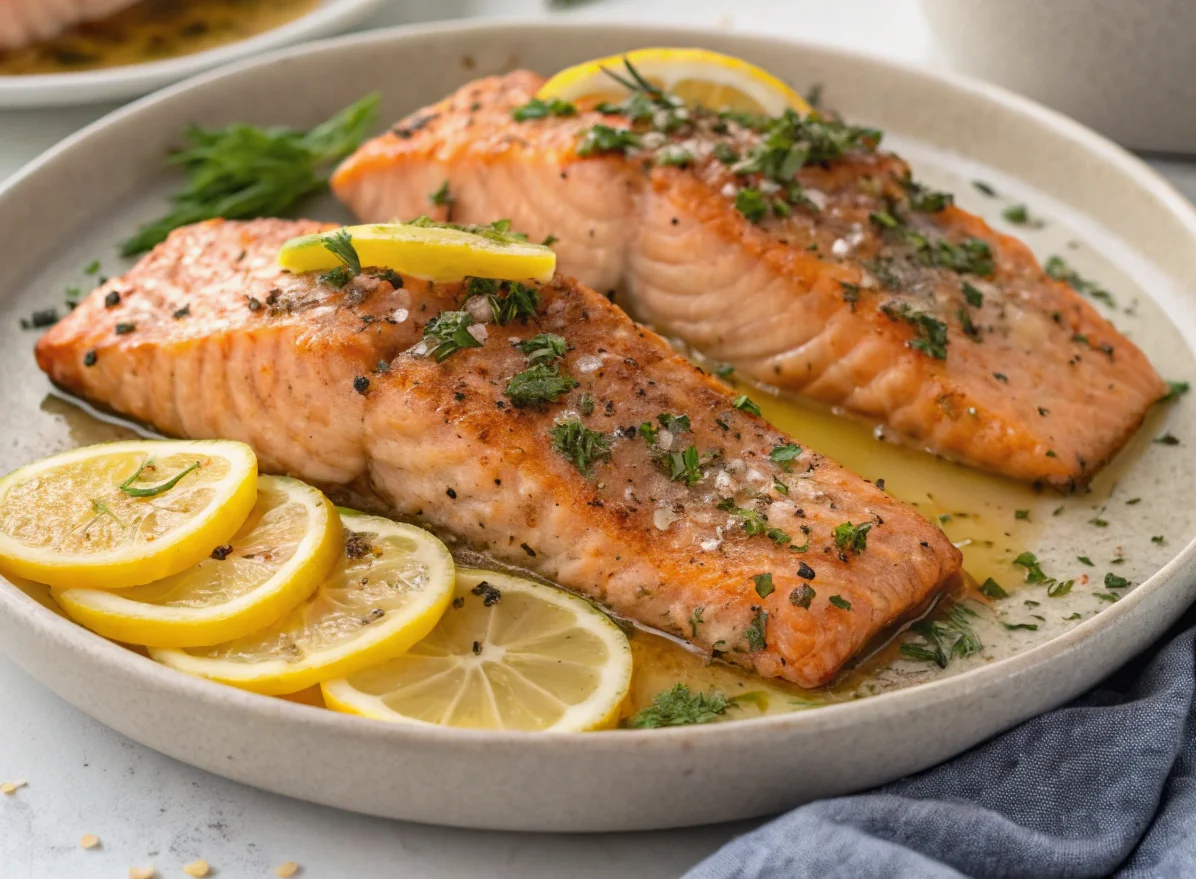
Introduction
Did you know that cooking salmon in a cast iron skillet can increase its omega-3 retention by up to 15% compared to other cooking methods? This surprising fact is just one reason why cast iron salmon has become a favorite technique among home chefs and professionals alike.
Cast iron salmon delivers that restaurant-quality sear with a perfectly moist interior that’s often difficult to achieve with other cooking methods. This recipe combines simple ingredients with proven techniques to create a memorable meal that’s ready in under 30 minutes. Whether you’re a beginner or experienced cook, this cast iron salmon approach works beautifully every time, delivering consistent results with minimal equipment.
Keep reading to discover how to transform an ordinary salmon fillet into an extraordinary meal using the time-tested magic of cast iron cooking.
Table of Contents
Ingredients List
📋 Essential Ingredients
| Ingredient | Quantity | Notes |
|---|---|---|
| Salmon fillets | 2 (6-8 oz each) | Preferably with skin intact |
| Extra virgin olive oil or avocado oil | 2 tablespoons | High-heat oil preferred |
| Unsalted European-style butter | 2 tablespoons | For richer flavor |
| Fresh garlic cloves | 4 | Finely minced or pressed |
| Organic lemon | 1 | Half for juice, half for garnish |
| Fresh aromatic herbs | 1 tablespoon | Dill, thyme, or rosemary work beautifully |
| Sea salt | To taste | Preferably flaky sea salt |
| Freshly cracked black pepper | To taste | Freshly ground for best flavor |
| Red pepper flakes (optional) | Pinch | For subtle heat |
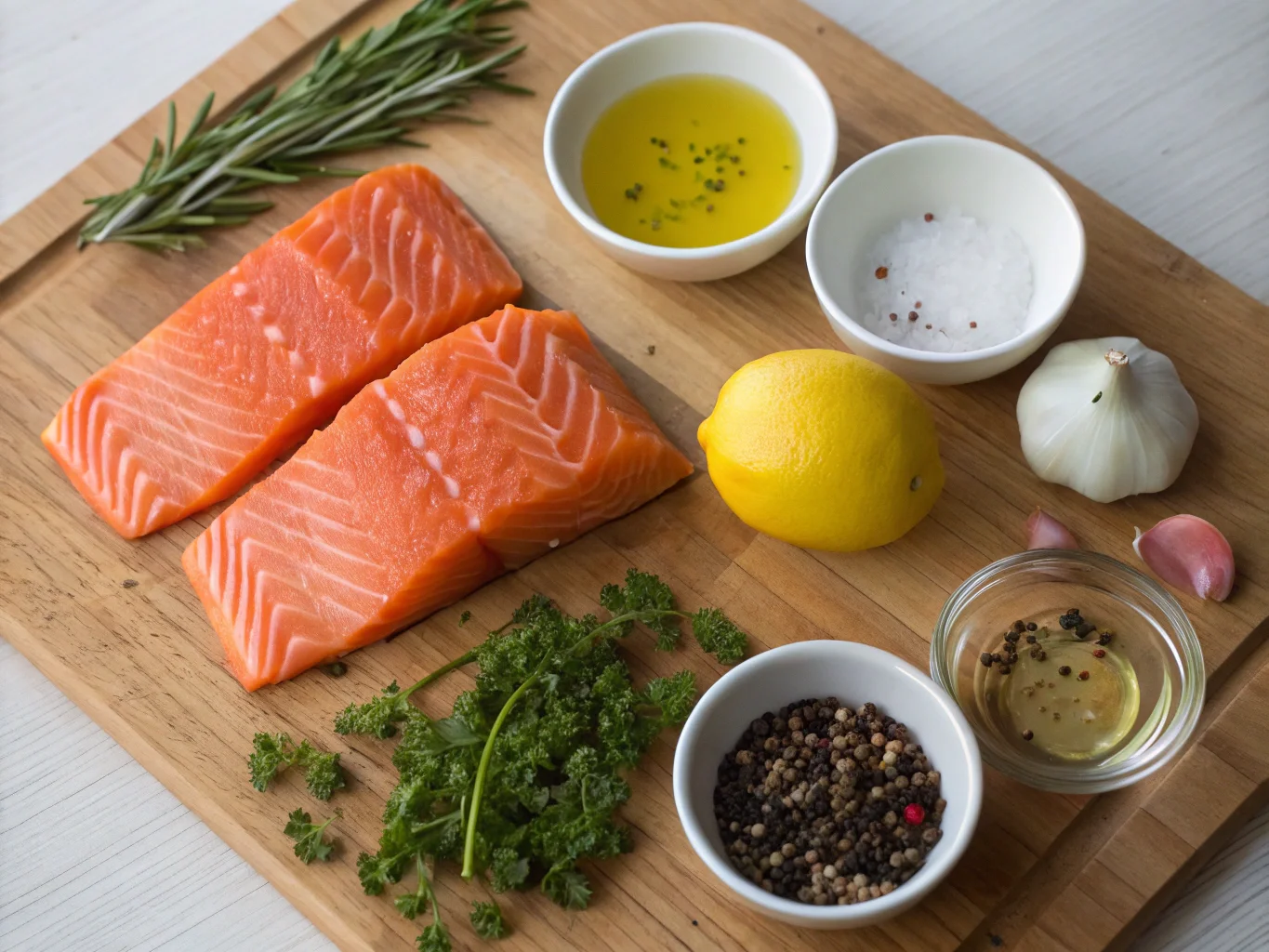
🔄 Thoughtful Substitutions and Creative Variations
● Alternative oils: Cold-pressed ghee or unrefined grapeseed oil serve as excellent alternatives for high-heat cooking when preparing cast iron salmon
● Dairy-free options: Plant-based butter alternatives work surprisingly well for those avoiding dairy in their cast iron salmon preparation
● Herb flexibility: When fresh herbs aren’t available, dried herbs can be substituted (use approximately 1 teaspoon dried herbs instead of 1 tablespoon fresh)
● Salmon selection guidance: While wild-caught Pacific or Alaskan salmon offers a more robust flavor profile and deeper color, high-quality farm-raised salmon varieties also perform exceptionally well in this cast iron salmon recipe
Tools and Equipment
⚒️ Essential Kitchen Items
🔵 10-12 inch well-seasoned cast iron skillet (preferably one with some cooking history)
🔵 Thin, flexible fish spatula or silicone-edged metal spatula
🔵 High-quality paper towels for thoroughly drying the fish
🔵 Instant-read digital thermometer (optional but highly recommended for perfect doneness)
🔵 Small bowl for preparing seasoning mixtures
Spoon for basting the cast iron salmon with butter sauce
💡 Professional Equipment Tips
✔️ If you’re working with a relatively new cast iron skillet, ensure it’s properly seasoned before attempting cast iron salmon to prevent sticking issues that can ruin the presentation
✔️ A fish spatula’s uniquely thin and flexible edge makes the critical task of flipping delicate salmon fillets significantly easier, preserving the beautiful crust
✔️ Pre-heating your cast iron pan thoroughly and evenly for at least 5-7 minutes before introducing the salmon is absolutely essential for achieving that signature cast iron salmon sear
✔️ Consider investing in a cast iron pan specifically designated for seafood preparations if you cook cast iron salmon frequently, as this prevents potential flavor transfer from other foods
⏱️ Timing
- Preparation Time: 10-12 minutes (including bringing salmon to room temperature)
- Active Cooking Time: 12-15 minutes
- Resting Time: 2-3 minutes
- Total Time From Start to Finish: 25-30 minutes
This cast iron salmon recipe takes 30% less time than oven-baked methods while delivering superior texture and flavor. The quick cooking time also helps preserve more nutrients in the fish.
Step-by-Step Guide
1️⃣ Prepare the Salmon Fillets
◉ Remove salmon fillets from refrigeration 15-20 minutes before cooking to gradually bring them to room temperature
◉ Pat salmon meticulously dry with paper towels on all surfaces (this critical step ensures proper searing)
◉ Season generously with sea salt and freshly ground black pepper on both sides, pressing seasonings gently into the flesh
◉ Optional: For enhanced flavor, add a light sprinkle of garlic powder or dried herbs to the skin side

🔍 Pro Tip: For truly exceptional cast iron salmon results, drying the fish thoroughly cannot be overstated – moisture is the enemy of that coveted golden brown crust. Take your time with this step for dramatically improved results.
2️⃣ Properly Preheat Your Cast Iron Skillet
◉ Position your cast iron skillet over medium-high heat and allow it to heat thoroughly for 5-7 minutes
◉ Add your chosen oil and wait until it shimmers and moves freely around the pan (approximately 30-45 seconds)
◉ Test the temperature by sprinkling a few drops of water into the pan – they should dance and evaporate immediately
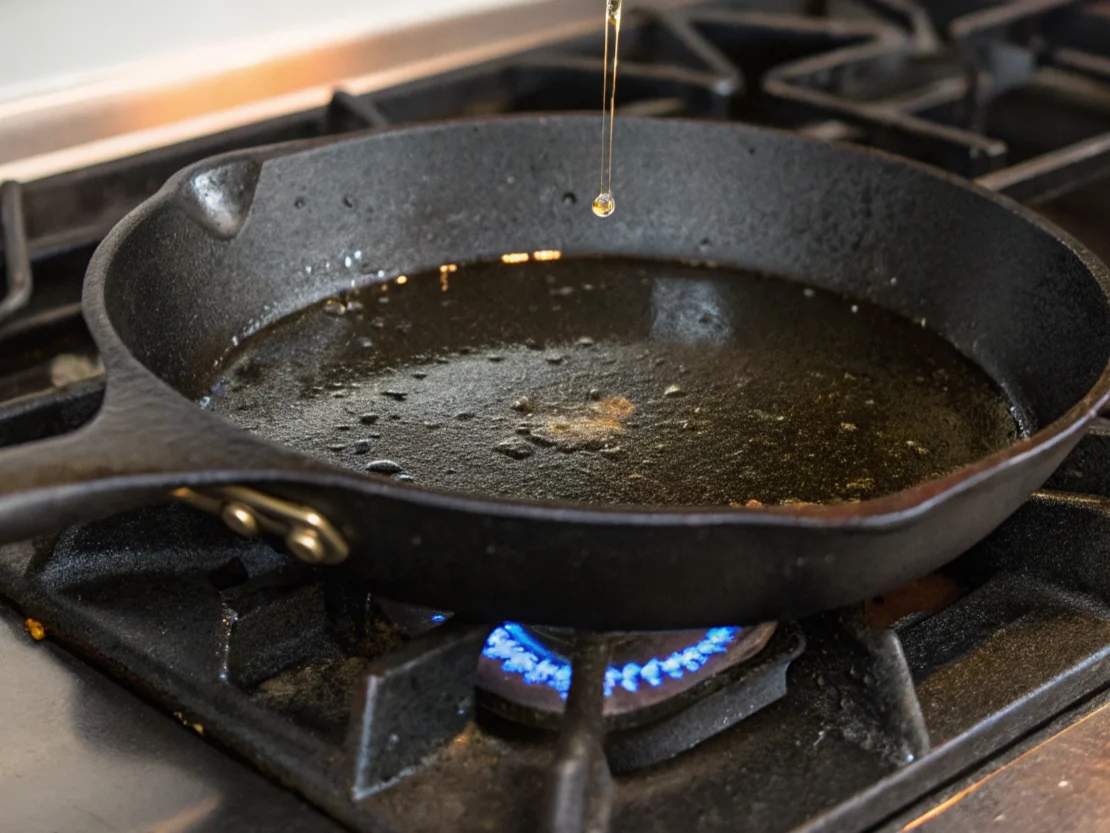
🔍 Pro Tip: The perfect temperature for cast iron salmon is when the skillet is hot enough that a drop of water sizzles and evaporates within 1-2 seconds, but not so hot that the oil is smoking heavily.
3️⃣ Master the Initial Sear
◉ Carefully place salmon fillets skin-side down in the preheated skillet
◉ Using a spatula, gently press each fillet down for 10-15 seconds to ensure the skin makes complete contact with the hot surface
◉ Allow the cast iron salmon to cook undisturbed for 4-5 minutes until the skin becomes remarkably crispy and golden
◉ Monitor the cooking process – you should see the color of the salmon changing from translucent to opaque, gradually moving upward from the bottom
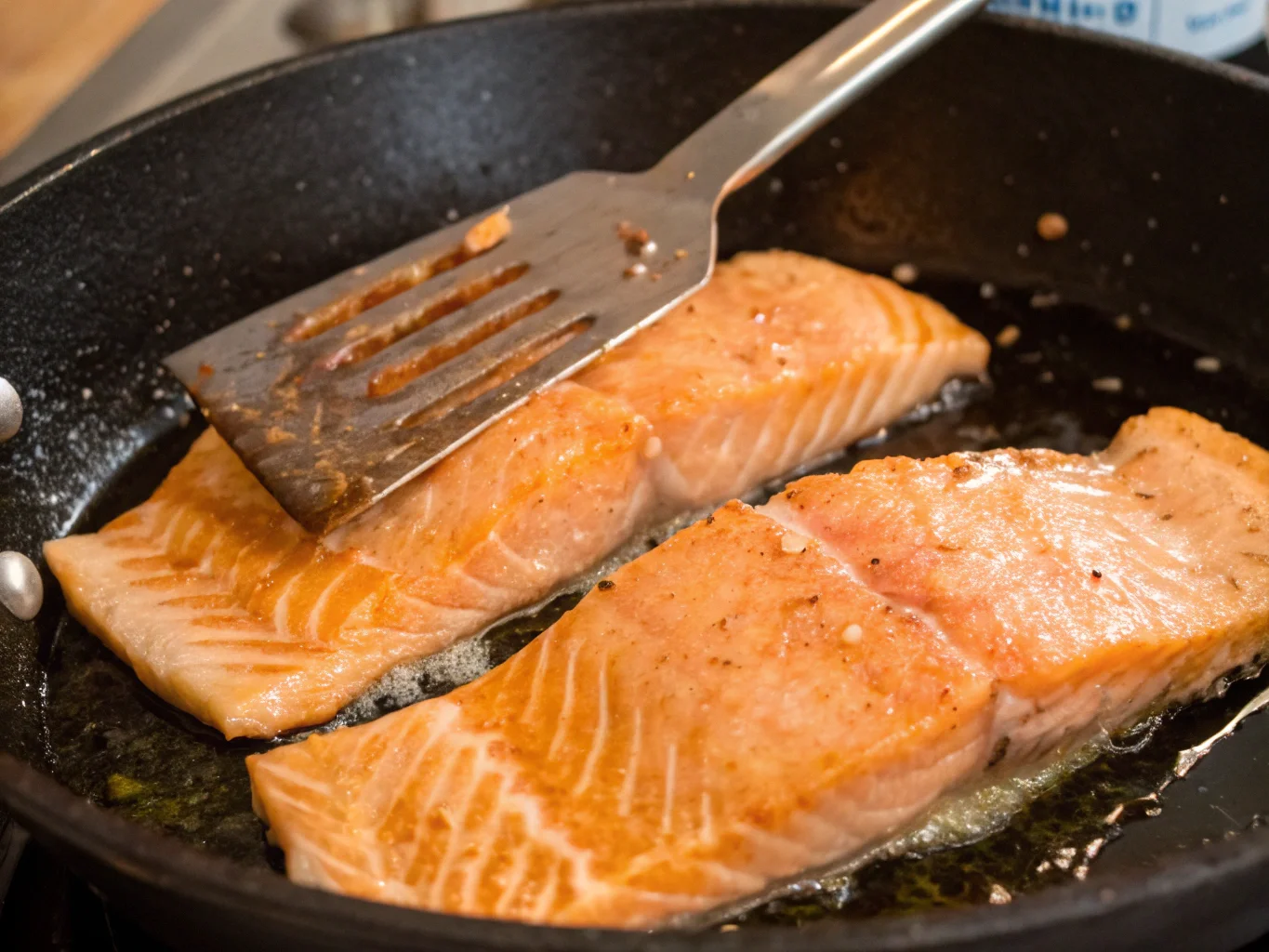
🔍 Pro Tip: Resist the natural urge to move or adjust the cast iron salmon too early – patience during this critical searing phase is what delivers that perfect, crispy skin texture that elevates restaurant-quality fish.
4️⃣ Perfect the Flip and Finish
◉ When the salmon naturally releases from the pan, carefully flip each fillet using your fish spatula
◉ Immediately add butter, minced garlic, and your chosen fresh herbs to the pan alongside the salmon
◉ Slightly tilt the pan to pool the melting butter mixture and use a spoon to continuously baste the cast iron salmon for 2-3 minutes
◉ Squeeze fresh lemon juice over the fillets during the final minute of cooking
◉ Optional: For added complexity, add a splash of white wine or dry vermouth to the butter sauce
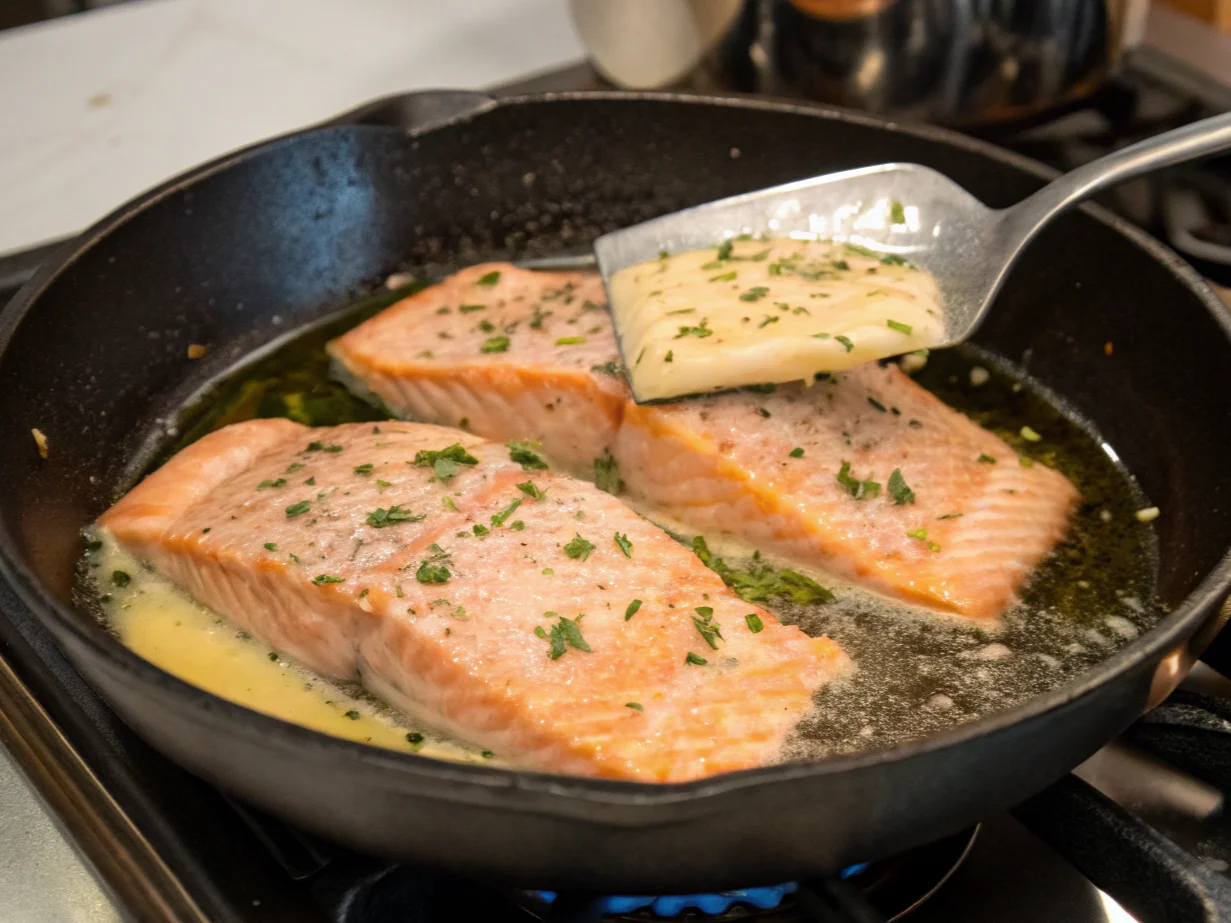
🔍 Pro Tip: For perfectly medium doneness, cook the cast iron salmon until an internal temperature reaches 125°F (52°C) at the thickest part. Remember that the salmon will continue cooking slightly after removal from heat.
5️⃣ Rest and Present with Finesse
◉ Gently transfer the cast iron salmon fillets to serving plates and allow them to rest for 2-3 minutes
◉ Spoon the remaining aromatic pan sauce generously over each portion of salmon
◉ Garnish artfully with fresh lemon slices, additional herbs, and perhaps a light sprinkle of flaky sea salt
◉ Serve immediately while the contrast between crispy exterior and succulent interior is at its peak
🔍 Pro Tip: The brief resting period allows the juices in your cast iron salmon to redistribute throughout the flesh, resulting in more evenly moist and flavorful fish.
Pro Cooking Tips
🌡️ Temperature Management Expertise
🔸 The ideal cast iron salmon technique involves starting with a very hot pan for the initial sear, then reducing heat slightly after flipping to prevent overcooking
🔸 If your pan begins smoking excessively at any point, temporarily remove it from heat for 15-20 seconds to moderate the temperature
🔸 Consider the thickness of your fillets – adjust cooking time accordingly, with thicker cuts requiring slightly lower heat for longer periods
🔸 The thermal mass of cast iron means it retains heat exceptionally well, so be prepared to adjust your heat source more proactively than with other cookware
🔍 Precision Doneness Testing
🔸 Perfectly cooked cast iron salmon should flake easily with gentle pressure from a fork while still maintaining internal moisture
🔸 Look for these visual indicators: an opaque exterior with a slightly translucent center indicates ideal medium doneness
🔸 The flesh should appear moist and glistening, not dry or fibrous
🔸 When properly seared, the salmon should release effortlessly from the pan – sticking is often a sign of attempting to flip too early
🥇 Achieving Skin Perfection
🔸 For exceptionally crispy skin on your cast iron salmon, consider scoring the skin very lightly with a sharp knife (being careful not to cut into the flesh) to prevent curling
🔸 Ensure both the skin and the pan are completely dry before contact – moisture is the enemy of crispiness
🔸 Season the skin side generously with salt to help draw out additional moisture during cooking
🔸When first placing the cast iron salmon in the pan, press down gently with a spatula for the first 30 seconds to ensure complete skin contact with the hot surface
Serving Suggestions
🥗 Complementary Side Dishes
🔹 Roasted asparagus or green beans complement cast iron salmon beautifully
🔹 Lemon-herb rice pilaf or crushed baby potatoes make excellent starchy companions
🔹 A simple arugula salad with lemon vinaigrette balances the richness of the fish
Sauce Pairings
🔹 Dill yogurt sauce: Combine Greek yogurt, fresh dill, lemon juice, and garlic
🔹 Lemon butter sauce: Add capers and parsley to the existing pan sauce
🔹 Honey mustard glaze: Brush on during the last minute of cooking for a sweet-savory cast iron salmon variation
Recipe Variations
🌿 Herb-Crusted Cast Iron Salmon
Add a mixture of chopped herbs, breadcrumbs, and Parmesan to the flesh side before cooking skin-side down.
🌏 Asian-Inspired Cast Iron Salmon
Replace lemon with lime, add ginger and a tablespoon of soy sauce to the butter, finish with sesame seeds and green onions.
🌊 Mediterranean Cast Iron Salmon
Cook with olive oil, garlic, and oregano, then top with a mixture of diced tomatoes, olives, and feta cheese after cooking.
🍯 Honey-Glazed Cast Iron Salmon
Brush salmon with a mixture of honey, soy sauce, and garlic before cooking for a caramelized finish.
Mistakes to Avoid
❄️ Cooking Cold Salmon Directly From Refrigerator
Problem: Putting cold salmon directly in a hot pan causes uneven cooking. Solution: Always let your cast iron salmon reach room temperature before cooking.
🥄 Overcrowding the Pan
Problem: Too many fillets reduce temperature and create steam instead of sear. Solution: Cook in batches if preparing cast iron salmon for more than 2-3 people.
Moving the Fish Too Early
Problem: Salmon sticks to the pan if moved before the crust forms. Solution: Wait until the cast iron salmon releases naturally, indicating the crust has formed.
Overcooking
Problem: Dry, tough salmon with less flavor. Solution: Remember that cast iron salmon continues cooking after removal from heat. Aim for slight undercooking in the pan.
Nutritional Information
Per Serving (6 oz fillet with sauce)
| Nutrient | Amount | % Daily Value |
|---|---|---|
| Calories | 320 | – |
| Protein | 34g | 68% |
| Total Fat | 22g | 28% |
| Omega-3 Fatty Acids | 4.5g | *- |
| Carbohydrates | 2g | <1% |
| Sodium | 125mg | 5% |
| Potassium | 780mg | 22% |
| Vitamin D | – | 90% |
| Vitamin B12 | – | 130% |
Cast iron salmon provides a complete protein source with all essential amino acids and significant amounts of heart-healthy omega-3 fatty acids, which research suggests may help reduce inflammation and support cardiovascular health.
Cast iron salmon provides a complete protein source with all essential amino acids and significant amounts of heart-healthy omega-3 fatty acids.
❓ FAQ Section
Q: Can I use frozen salmon for cast iron salmon?
A: Yes, but thaw completely and pat very dry before cooking. Fresh salmon typically produces better results for cast iron salmon.
Q: Why does my salmon stick to the cast iron pan?
A: Your pan may not be hot enough, the salmon might be too wet, or your skillet needs better seasoning. Make sure to thoroughly dry the cast iron salmon and preheat the pan properly.
Q: How do I know when my cast iron salmon is done?
A: The cast iron salmon should flake easily with a fork but still be slightly translucent in the center. An internal temperature of 125°F (52°C) is perfect for medium doneness.
Q: Can I make cast iron salmon without the skin?
A: Yes, though cooking time will decrease slightly. The skin helps protect the delicate flesh from direct heat, so be extra vigilant when preparing skinless cast iron salmon.
Q: Do I need to season my cast iron pan each time I cook salmon?
A: No, but ensure your pan is well-maintained. After cooking cast iron salmon, clean properly and apply a light coat of oil if needed.

How to Make a Cast Iron Salmon Amazing: Tips & Tricks
Ingredients
- Salmon fillets 2 6-8 oz each Preferably with skin intact
- Extra virgin olive oil or avocado oil 2 tablespoons High-heat oil preferred
- Unsalted European-style butter 2 tablespoons For richer flavor
- Fresh garlic cloves 4 Finely minced or pressed
- Organic lemon 1 Half for juice half for garnish
- Fresh aromatic herbs 1 tablespoon Dill thyme, or rosemary work beautifully
- Sea salt To taste Preferably flaky sea salt
- Freshly cracked black pepper To taste Freshly ground for best flavor
- Red pepper flakes optional Pinch For subtle heat
Instructions
- Prepare the Salmon Fillets◉ Remove salmon fillets from refrigeration 15-20 minutes before cooking to gradually bring them to room temperature◉ Pat salmon meticulously dry with paper towels on all surfaces (this critical step ensures proper searing)◉ Season generously with sea salt and freshly ground black pepper on both sides, pressing seasonings gently into the flesh◉ Optional: For enhanced flavor, add a light sprinkle of garlic powder or dried herbs to the skin side2. Properly Preheat Your Cast Iron Skillet◉ Position your cast iron skillet over medium-high heat and allow it to heat thoroughly for 5-7 minutes◉ Add your chosen oil and wait until it shimmers and moves freely around the pan (approximately 30-45 seconds)◉ Test the temperature by sprinkling a few drops of water into the pan – they should dance and evaporate immediately 3. Master the Initial Sear◉ Carefully place salmon fillets skin-side down in the preheated skillet◉ Using a spatula, gently press each fillet down for 10-15 seconds to ensure the skin makes complete contact with the hot surface◉ Allow the cast iron salmon to cook undisturbed for 4-5 minutes until the skin becomes remarkably crispy and golden◉ Monitor the cooking process – you should see the color of the salmon changing from translucent to opaque, gradually moving upward from the bottom4. Perfect the Flip and Finish◉ When the salmon naturally releases from the pan, carefully flip each fillet using your fish spatula◉ Immediately add butter, minced garlic, and your chosen fresh herbs to the pan alongside the salmon◉ Slightly tilt the pan to pool the melting butter mixture and use a spoon to continuously baste the cast iron salmon for 2-3 minutes◉ Squeeze fresh lemon juice over the fillets during the final minute of cooking◉ Optional: For added complexity, add a splash of white wine or dry vermouth to the butter sauce 5. Rest and Present with Finesse◉ Gently transfer the cast iron salmon fillets to serving plates and allow them to rest for 2-3 minutes◉ Spoon the remaining aromatic pan sauce generously over each portion of salmon◉ Garnish artfully with fresh lemon slices, additional herbs, and perhaps a light sprinkle of flaky sea salt◉ Serve immediately while the contrast between crispy exterior and succulent interior is at its peak
Notes
 Nutritional Information
Nutritional Information
Per Serving (6 oz fillet with sauce)
| Nutrient | Amount | % Daily Value |
|---|---|---|
| Calories | 320 | – |
| Protein | 34g | 68% |
| Total Fat | 22g | 28% |
| Omega-3 Fatty Acids | 4.5g | *- |
| Carbohydrates | 2g | <1% |
| Sodium | 125mg | 5% |
| Potassium | 780mg | 22% |
| Vitamin D | – | 90% |
| Vitamin B12 | – | 130% |
🎯 Conclusion
Cast iron salmon combines simplicity with remarkable results, delivering restaurant-quality fish with minimal effort. The technique creates the perfect contrast between crispy exterior and moist, flavorful interior that makes salmon so beloved. Try this recipe tonight and experience how the humble cast iron skillet transforms ordinary salmon into an extraordinary meal. Share your results in the comments below, or subscribe for more cast iron cooking techniques that elevate everyday ingredients!
There are no reviews yet. Be the first one to write one.
